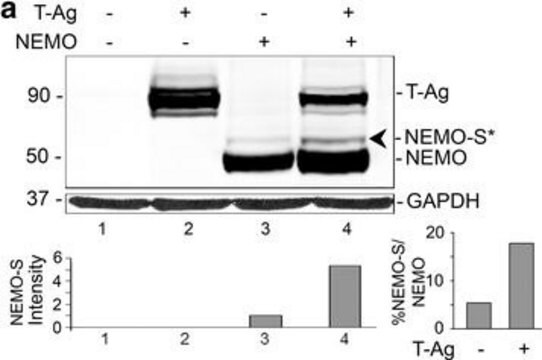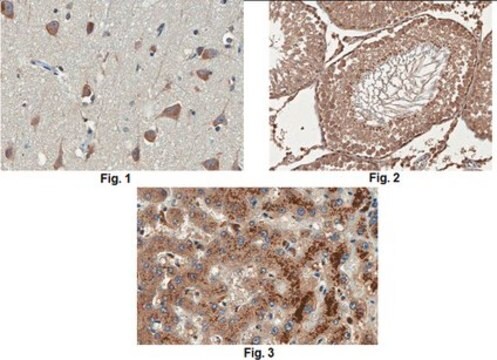MABS1221
Anti-GLEPP1/PTPRO Antibody, clone 5C11
clone 5C11, from mouse
Sinonimo/i:
Receptor-type tyrosine-protein phosphatase O, Glomerular epithelial protein 1, Osteoclastic transmembrane protein-tyrosine phosphatase, Protein tyrosine phosphatase U2, PTP-OC, PTP phi, PTP-U2, PTPase U2, R-PTP-O
About This Item
Prodotti consigliati
Origine biologica
mouse
Livello qualitativo
Forma dell’anticorpo
purified antibody
Tipo di anticorpo
primary antibodies
Clone
5C11, monoclonal
Reattività contro le specie
human
Non deve reagire con
mouse, rat, rabbit
tecniche
electron microscopy: suitable
immunofluorescence: suitable
immunohistochemistry: suitable
Isotipo
IgG2bκ
N° accesso NCBI
N° accesso UniProt
Condizioni di spedizione
wet ice
modifica post-traduzionali bersaglio
unmodified
Informazioni sul gene
human ... PTPRO(5800)
Descrizione generale
Specificità
Immunogeno
Applicazioni
Immunofluorescence Analysis: Prior to purification, clone 5C11 hybridoma culture supernatant detected GLEPP1 (PTPRO) immunoreactivity predominantly on visceral glomerular epithelial cell (VGEC) foot processes along the glomerulus (GBM) in manthanol-fixed, adult human kidney cryosections, while altered GLEPP1 staining patterns were seen in kidney sections from individuals with congenital nephrotic syndrome of the Finnish type (CNF), minimal-change nephropathy (MCN), or Hodgkin’s disease (Sharif, K., et al. (1998). Exp. Nephrol. 6(3):234-244).
Electron Microscopy Analysis: Prior to purification, clone 5C11 hybridoma culture supernatant detected GLEPP1 (PTPRO) immunoreactivity at the apical aspect of the foot processes and the cell membrane of larger processes in paraformaldehyde-fixed, paraffin-embedded normal human adult kidney sections, while GLEPP1 immunoreactivity was seen redistributed from glomerulus (GBM) on the apical cell membrane of VGECs to microvilli on kidney sections from individuals with congenital nephrotic syndrome of the Finnish type (CNF) or minimal-change nephropathy (MCN) (Sharif, K., et al. (1998). Exp. Nephrol. 6(3):234-244).
Qualità
Immunohistochemistry Analysis: A 1:50 dilution of this antibody detected GLEPP1/PTPRO in human kidney tissue.
Descrizione del bersaglio
Stato fisico
Altre note
Non trovi il prodotto giusto?
Prova il nostro Motore di ricerca dei prodotti.
Codice della classe di stoccaggio
12 - Non Combustible Liquids
Classe di pericolosità dell'acqua (WGK)
WGK 1
Punto d’infiammabilità (°F)
Not applicable
Punto d’infiammabilità (°C)
Not applicable
Certificati d'analisi (COA)
Cerca il Certificati d'analisi (COA) digitando il numero di lotto/batch corrispondente. I numeri di lotto o di batch sono stampati sull'etichetta dei prodotti dopo la parola ‘Lotto’ o ‘Batch’.
Possiedi già questo prodotto?
I documenti relativi ai prodotti acquistati recentemente sono disponibili nell’Archivio dei documenti.
Il team dei nostri ricercatori vanta grande esperienza in tutte le aree della ricerca quali Life Science, scienza dei materiali, sintesi chimica, cromatografia, discipline analitiche, ecc..
Contatta l'Assistenza Tecnica.







